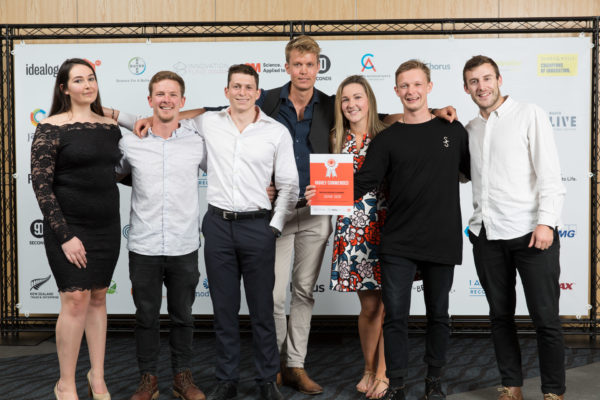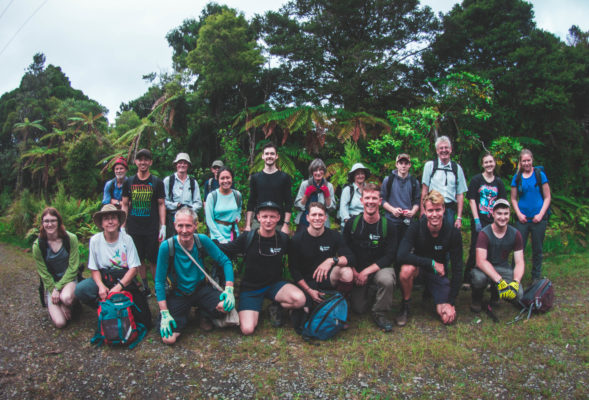A while back the Squawk Squad team were thinking about how they could get people more interested in birds in the lead-up to the December launch of their Squawk Squad app. Conservation Week in October seemed like an ideal opportunity just waiting to be grabbed.

“We were thinking about how we could blow it up and make it the biggest ever” says co-founder and team leader Fraser McConnell. “We decided to put together an online digital conservation education pack that was interactive and engaging, pulling together lesson plans and resources that were already out there.”
The team sourced material from organisations such as DOC and Zealandia, bringing together a host of resources in one easy-to-access location.
“We set it up and did some user testing. In the first week we thought we might get 2000 sign ups, instead we had 23,000 and after 3 weeks there were 40,000 kids signed up across 800 schools.”
Those 40,000 Squawk Squad Rangers weren’t just sitting hooked up to their computer screens learning about birds online.
“We used the digital platform to get kids outside,” Fraser explains. “It got kids making and setting rat-tracking tunnels, there was a bird trading card game and we ran a competition for kids to find the classroom that could recruit the most whanau and friends to sponsor traps for a sanctuary.
The winning classroom was Room 14 of Belmont Primary School in Auckland who then got to come to the official Squawk Squad app launch at Ark in the Park.
“They were New Zealand’s greatest Squawk Squad Rangers,” says Fraser. “They were incredible. One boy signed up the school principal on the first day and another made a video of himself. Kids had playdates where they were handing out hand-drawn posters.”
The Squawk Squad team live-streamed a video each morning, giving updates… on which class had won the daily prize and announcing the top 10 classes in the competition.
“We got videos back made by the teachers showing the kids excited reaction when they learned they were No. 2 etc,” Fraser says.
Come December, Room 14 were there for the app launch, along with other guests including Maggie Barry, MP Alfred Ngaro, DOC’s Predator Free Ranger Katharine Lane and the Ark in the Park Team. But what exactly is the Squawk Squad app and where did it all begin…
It started with a conversation. Fraser and co-founder Alex Hannon are mechanical engineers and mates from University days. They got together and got talking about wanting to do something that wasn’t about the money – something that would benefit New Zealand. The conversation turned to conservation and when they looked into the issues facing New Zealand wildlife, they realised they’d found their mission. Conservation needed all the help it could get.
But how could they make a difference? What could any – or better still MANY – New Zealanders do to help? Sanctuaries and volunteer trapping groups are doing great work but need more funding for more traps. They need more volunteers – and/or more efficient, less time-consuming trapping methods to make the most of the volunteer hours they have. Not everyone can volunteer – but everyone can potentially help fund self-resetting traps.
Fraser and Alex wanted to do more than persuade people to donate money, however. They wanted everyone to see what their donation was doing and to get more closely involved.
Their idea was for donors to help sponsor a trap and, through an app, have a live connection to the trap they helped fund, with a notification to their smart phone when their self-resetting trap was triggered.
The real initiation was made when they decided to take their idea to Start-up Weekend Auckland in November 2016. They grew their team, including the addition of their Marketing Technologist and developer, Racheal Herlihy and Operations Lead, Odette Colebrook – and came home winners. They continued to win awards in 2017 including a WWF Innovation Conservation award and being awarded highly commended at the NZ Innovation Awards. All in all, 2017 was a hectic and successful year.
“We started our kickstarter in May, aiming to raise $20,000 to help North Island kokako at Ark in the Park in the Waitakeres,” says Fraser. “In one month we’d raised $70,000 so we upscaled the first project and funded a second project. The second project was decided by audience vote – the Te Rere Penguin Reserve in the Catlins.”
A third project – Thames Coast Kiwi Care – has now also been completely funded, with a lot of new people coming on board as funders and many ‘gift traps’ purchased for friends in the lead-up to Christmas. Fund-raising is now underway to purchase 60 self-resetting traps for Squawk Squad’s fourth project at Pukaha Mt Bruce.

The self-resetting traps are manufactured by Goodnature, with sensor nodes designed by Encounter Solutions.
“Self-resettable traps can be expensive so a Squawk Squad is created to break down the cost of conservation into bite size pieces. Each Squad member contributes to the total cost of the trap, sensor node and full set-up. Sanctuaries receive our traps and technology and are only responsible for the gas and lure replacements and the minimal ongoing data costs. Each member of the Squad sees where their trap is deployed and is notified every time the trap activates. Key metrics such as number of pests trapped, the sanctuary leader board, bird noise level and reintroduced species are relayed back to the Squad members.”
Not only do sanctuaries and volunteer groups receive the full trap setup for free, but the labour cost-savings can also be huge.
“Over 3 years a 500 trap grid of our trapping systems can save over 10,000 hours of labour time or 1,300 worker days! Locating, checking, clearing and resetting conventional traps is extremely inefficient and can consume as much as 80% of a sanctuaries time. We equip sanctuaries with a live view of all funded traps, when they activate and therefore when they need refuelling. This means that instead of having to check a traditional trap every week, whether it has or has not triggered, the sanctuaries can leave the funded traps for up to 6 months!”
While the basic Squawk Squad app is now live and notifying, Fraser and the team plan to add new features soon – including a feature showing the bird noise level in the park where the trap is situated. So Squawk Squad members, even those stuck in an office in the city, can check out how their trap is doing and, over time, how birdlife in their park is responding, to a newfound freedom from predators.
Too busy to check a trapline – no worries – help sponsor a trap and check your phone app instead…

